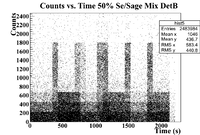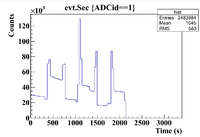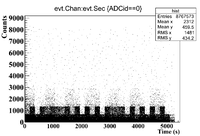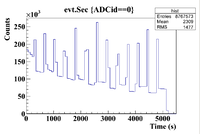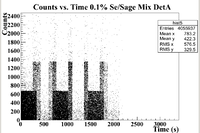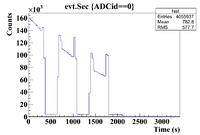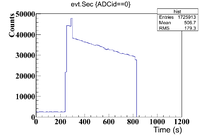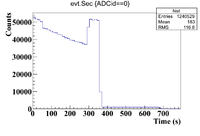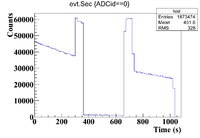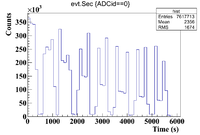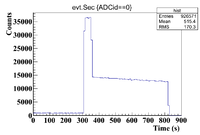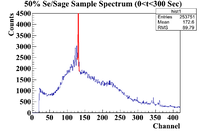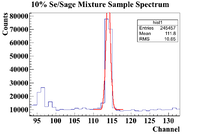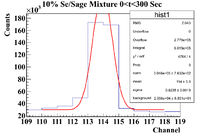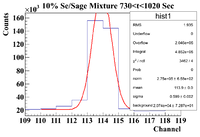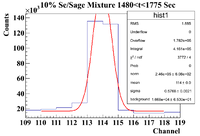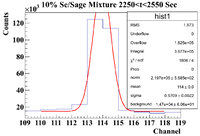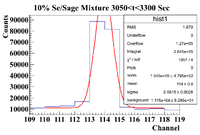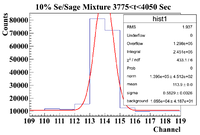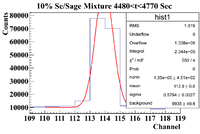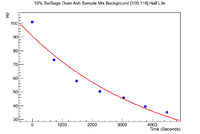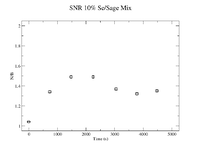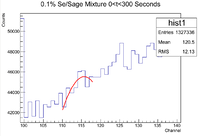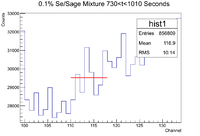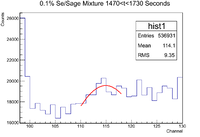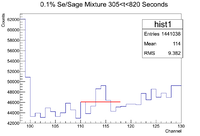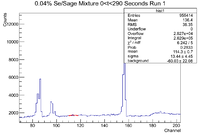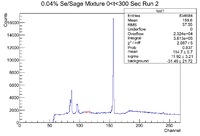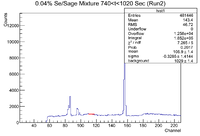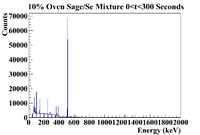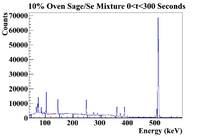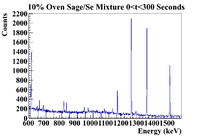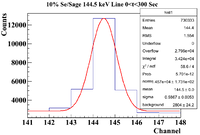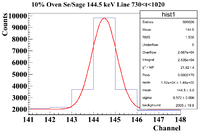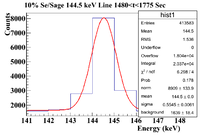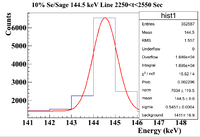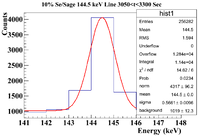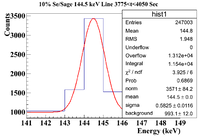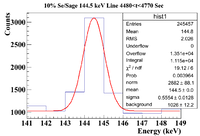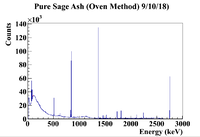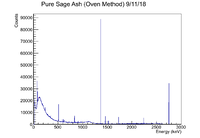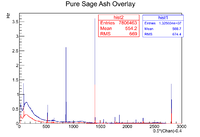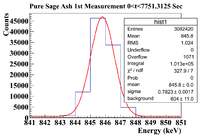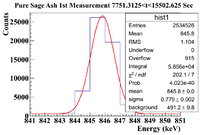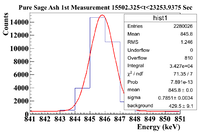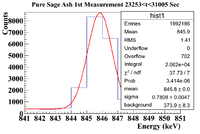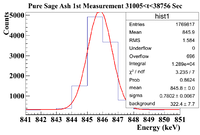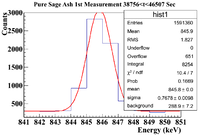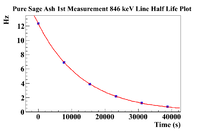Difference between revisions of "LB SageBrushWork PostDefense"
| Line 326: | Line 326: | ||
4100-4350 (Pure Se, good) | 4100-4350 (Pure Se, good) | ||
| − | + | 4370-4420 (Co-60, good) | |
4480-4670 (Mixture) | 4480-4670 (Mixture) | ||
Revision as of 20:20, 19 September 2018
Mass Information
Note that only 2 samples were produced using the oven method (0.04% and 10%). The target masses are as follows
50% Se/Sage Sample
| Selenium Target (50% Sagebrush Se Mix) | Mass (g) |
| Outer Front Ni Foil | 0.6948 |
| Se Mass | 0.51 |
| Outer Se Mass | 0.1 |
| Sagebrush Leaves Mass | 0.4969 |
10% Sample
| Selenium Target (10% Sagebrush Se Mix) | Mass (g) |
| Outer Front Ni Foil | 0.2783 |
| Se Mass | 0.0523 |
| Outer Se Mass | 0.0971 |
| Sagebrush Leaves Mass | 0.5111 |
0.1% Se/Sage Sample
| Selenium Target (0.1% Sagebrush Se Mix) | Mass (g) |
| Outer Front Ni Foil | 1.1437 |
| Se Mass | 0.0559 |
| Outer Se Mass | 0.1118 |
| Sagebrush Leaves Mass | 50.1080 |
0.04% Sample
| Selenium Target (0.04% Sagebrush Se Mix) | Mass (g) |
| Outer Front Ni Foil | 0.5447 |
| Se Mass | 0.0020 |
| Outer Se Mass | 0.0992 |
| Sagebrush Leaves Mass | 4.9326 |
Time Cuts
The first step in the PAA process is to identify the time cuts used for the split run. This must be done for all samples (50%,10%,0.1%, and 0.04%).
50% Sage/Se Mixture Time Cuts
The 50% Se/Sage mixture was measure on Detector B (unshielded, so watch the SNR) on 5/24/17 for a total of 2130.540 seconds. The outer pure witness Se was measure first, and sub-run was roughly 300 seconds for the samples of interest, and 60 seconds for the Co-60 flag. The root command used to draw the timing information was
TTree* tree = MPA;
MPA->Draw("evt.Chan:evt.Sec>>hist2","evt.ADCid == 1");
which produced the histogram below
This seems a little sloppy, lets try a 1D histogram instead to see if the cuts are more clear
ROOT Command: MPA->Draw("evt.Sec>>hist","ADCid==1","");
This produced the histogram below
This seems much cleaner and clearly shows the time cuts
The time cuts are
0-300 (Pure Se)
375-440 (Co-60)
450-700 (Mixture)
715-780 (Co-60)
800-1010 (Pure Se)
1055-1150 (Co-60)
1160-1420 (Mixture)
1425-1495 (Co-60)
1500-1800 (Pure Se)
1810-1870 (Co-60)
1880-2100 (Mixture)
10% Sage/Se Mixture Time Cuts
The 10% Se/Sage mixture was measured on Detector A (shielded) on 5/25/17 for a total of 5136.343 seconds. The mixture was measured first, and a sub-run was roughly 300 seconds for the Se samples and 60 seconds for the Co-60 flag. The root commands used were
TTree* tree = MPA;
MPA->Draw("evt.Chan:evt.Sec>>hist2","evt.ADCid == 0");
The time cut information is as follows
0-300 (Mixture)
300-360 (Co-60)
400-640 ( Pure Se)
680-710 (Co-60)
730-1020 (Mixture)
1030-1080 (Co-60)
1100-1360 ( Pure Se)
1400-1440 (Co-60)
1480-1775 (Mixture)
1800-1840 (Co-60)
1875-2150 (Pure Se)
2190-2220 (Co-60)
2250-2550 (Mixture)
2590-2620 (Co-60)
2650-2930 (Pure Se)
2950-3000 (Co-60)
3050-3300 (Mixture)
3390-3350 (Co-60)
3400-3690 (Pure Se)
3700-3750 (Co-60)
3775-4050 (Mixture)
4060-4100 (Co-60)
4120-4400 (Pure Se)
4420-4470 (Co-60)
4480-4770 (Mixture)
4790-4820 (Co-60)
4840-5130 (Pure Se)
0.1% Sage/Se Mixture Time Cuts
The 0.1% Se/Sage mixture was measured on Detector A (shielded) on 5/24/17 for a total of 2130.540 seconds. The mixture was measured first, and a sub-run was roughly 300 seconds for the Se samples and 60 seconds for the Co-60 flag. The root commands used were
TTree* tree = MPA;
MPA->Draw("evt.Chan:evt.Sec>>hist2","evt.ADCid == 0");
which produced the histogram below
This seems a little sloppy, so let's repeat the procedure for the 50% sample
ROOT Command:ROOT Command: MPA->Draw("evt.Sec>>hist","ADCid==0","");
This produced the histogram below
This is again much better than the 2D histogram.
The time cuts are
0-300 (Mixture)
306-340 (Co-60)
376-640 (Pure Se)
650-720 (Co-60)
730-1010 (Mixture)
1020-1050 (Co-60)
1100-1350 (Pure Se)
1400-1460 (Co-60)
1470-1730 (Mixture)
1735-1800 (Co-60)
1804-2140 (Pure Se)
The histogram for the time cuts of the second run is shown below
The time cuts are
0-240 (Outer Se)
245-300 (Co-60)
305-820 (Mixture)
0.04% Sample Time Cuts
The 0.04% Se/Sage mixture was measured on Detector A (shielded) on 5/25/17 for a total of 1711.891 seconds. The mixture was measured first, and a sub-run was roughly 300 seconds for the Se samples and 60 seconds for the Co-60 flag. The root commands used were
TTree* tree = MPA;
MPA->Draw("evt.Sec>>hist2","evt.ADCid == 0");
The histogram representing the time cuts for the first run are shown below
The time cuts for this run are
0-290 (Mixture)
295-360 (Co-60)
370-684 (Pure Se)
The histogram representing the time cuts for the second run are shown below
The time cuts for this run are
0-300 (Mixture)
305-355 (Co-60)
360-650 (Pure Se)
660-735 (Co-60)
740-1020 (Mixture)
The histogram representing the time cuts for the third run are shown below
It would appear that first two time cuts are difficult to determine because the Co-60 flag's counts are on the same order as the sample's, so watch out for this next time! Each run should be roughly 300 seconds for the sample and 60 seconds for the Co-60 flag, so check the histograms to make sure there are no Co-60 lines to correct for this. To double check these time cuts I looked for Cl-34m in the mixture (which according to my 10% analysis was not present in the pure Se sample) and the Co-60 lines that may have overlapped. It seems there is a line near 1773 keV present in the mixture, but the 1332 keV line is missing in the mixture. Keep an eye out.
0-300 (Mixture,145 keV 1173 present | 1332 keV not present,good)
305-350 (Co-60, good)
360-650 (Pure Se, good)
660-710 (Co-60, good)
720-940 (Mixture, good)
1020-1070 (Co-60, good)
1100-1240 (Pure Se, good)
1270-1310 (Co-60, good)
1320-1630 (Mixture, good)
1660-1720 (Co-60, good)
1740-2030 (Pure Se, good)
2040-2120 (Co-60, good)
2130-2420 (Mixture, good)
2430-2490 (Co-60, good)
2500-2800 (Pure Se, good)
2810-2850 (Co-60, good)
2880-3150 (Mixture, good)
3170-3220 (Co-60, good)
3240-3510 (Pure Se, good)
3520-3580 (Co-60, good)
3600-3970 (Mixture, good)
4000-4060 (Co-60, good)
4100-4350 (Pure Se, good)
4370-4420 (Co-60, good)
4480-4670 (Mixture)
4680-4880 (Co-60)
4890-5090 (Pure Se)
5100-5200 (Co-60)
5210-5400 (Mixture)
5410-5600 (Co-60)
Below is the histogram representing the time cuts for the 4th run
Below are the time cuts
0-300 (Pure Se)
306-359 (Co-60)
362-818 (Mixture)
Gamma Spectrum Analysis
50% Sample Analysis
Below is the analysis table for the 50% Se/Sage mixture. The 103 keV line of Se-81m corresponds to a channel # of 130. Due to the sloppiness of the spectrum, I will use a linear + Gaussian fitting function and restrict my analysis to 6 channels because there are other energy lines nearby. Below is a sample spectrum for an idea of the resolution of Detector B for this measurement
As a comparison for the constant fit, here is a sample spectrum of the Se/Sage measured by Detector A
| 0<t<300 | ||
| Thin Window Histogram | ||
| Signal in Thin Window | ||
| Integrated Background | ||
| Signal - Background | ||
| Runtime (s) | ||
| Rate (Hz) | ||
| Integral Decay Correction (Hz) | ||
| Dead Time (%) | ||
| Dead Time Corrected Signal (Hz) | ||
| .Dat File Entry For HL Plot |
10% Sample Analysis
Below is the analysis table for the 10% Se/Sage mixture. The 103 keV line of Se-81m corresponds to a channel # of 113
Background and SNR Information
Below is a plot of the background in a 10 channel window around the short lived half life's energy peak of interest (103 keV). The long lived half live can be measured for at least a year even in a 0.1% by mass concentration, so it is less pressing. The values presented are weighted by the mass of the sage ash.
The fit parameters are
Constant: 4.50734e+00 +/- 2.42037e-03
Slope: -2.31438e-04 +/- 1.05610e-06
Which gives a rough half life of 49.92 +/- 0.23 minutes
Below is the SNR plotted in xmgrace
0.1% Sample Analysis
Below is the analysis table for the 0.1% Mixture, the 103 keV line for Se-81m corresponds to a channel # of 113.
0.04% Sample Analysis
Fall 2018 Possible Sage Irradiation Activity Prediction
Isotope Search link: http://nucleardata.nuclear.lu.se/toi/
For this section I will attempt to identify the most active line within a sagebrush sample. The histograms that follow in this section will be weighted by the mass of the sage that was used for the sample. I will use the 10% Sage/Se mixture because it was processed using the oven method for dehydration. The mass was 0.5111g which gives a weighting factor of 1.9566 Below is a full spectrum for the time cut of 0 <t< 300 seconds.
It seems the two most prominent lines are around 150 keV and 250 keV, so let's try to study the decay of those first.
144.5 keV Line
Note: the x-axis for the first 2 histograms should be Energy (keV). This line is NOT present in the Pure Se Sample, so it should be a line produced by the sage itself.
Without any corrections, the half life here is 38.61 0.84 minutes. This is likely Cl-34m (32 min half life) produced by a (g,n) reaction on Cl-35 (75.76% natural abundance), which is stable, because a second line characteristic of Cl-34m was found (1176 keV). This could also be produced by a (g,pn) knockout on Ar-36 in air. This is chlorine since using the isotope search with an energy uncertainty of 5 keV and a half life uncertainty of 10 minutes, the only isotope that shared 146 and 1176 keV with branching ratios that made sense was Cl-34m.
9/10/18 Irradiation
The mass information is
Al Cylinder: 26.0249g
Sage Ash (oven method): 2.0913g
Beam off: 18:30
Calibration
Below is the runlist used for the calibration on Detector D
| Source | Serial No. | Reference Date | Activiy | Half life | Expected Energies (keV) | Line Seen (Channel No.) | Runtime (s) | Position | File Name | Date Measured |
| Mn-54 | J4-348 | 8/1/12 | 9.882 uCi | 312.20 days | 834.827 | 835.117 | 300.601 | 10 | LB_Mn_54_9_10_18_Pos10_DetD | 9/10/18 |
| Cs-137 | 129793 | 7/1/08 | 1.066 uCi | 30.08 years | 661.657 | 661.887 | 141.356 | 10 | LB_Cs137_9_10_18_Pos010_DetD | 9/10/18 |
| Co-60 | 129739 | 07/01/08 | 1.082 uCi | 1925.28 days | 1173.228, 1332.492 | 1173.338, 1332.564 | 232.521 | 10 | LB_Co60_9_10_18_Pos010_DetD | 9/10/18 |
| Ba-133 | 129790 | 07/01/08 | 1.188 uCi | 10.551 years | 80.9979, 276.3989, 302.8508, 356.0129, 383.8485 | 81.391, 276.741, 303.166, 356.315, 384.137 | 250.816 | 10 | LB_Ba133_9_10_18_Pos010_DetD | 9/10/18 |
The calibration coefficients are (according to my fits)
Intercept = -0.370972 +/- 0.616
Slope = 0.490352 +/- 0.000534241
The calibration used at the IAC was
Intercept = 0.272366
Slope = 0.490198
Efficiency
Below is a table of the runlist used for the efficiency on Detector D.
| Source | Serial No. | Reference Date | Activiy | Half life | Expected Energies (keV) | Start | Stop | Runtime (s) | Position | File Name | Date Measured |
| Mn-54 | J4-348 | 8/1/12 | 9.882 uCi | 312.20 days | 828.859 | 12:45 | 12:50 | 300.601 | 10 | LB_Mn_54_9_10_18_Pos10_DetD | 9/10/18 |
| Mn-54 | J4-348 | 8/1/12 | 9.882 uCi | 312.20 days | 828.859 | 12:52 | 12:57 | 305.787 | 20 | LB_Mn_54_9_10_Pos020_DetD | 9/10/18 |
| Mn-54 | J4-348 | 8/1/12 | 9.882 uCi | 312.20 days | 828.859 | 12:59:41 | 113:04 | 300.734 | 30 | LB_Mn_54_9_10_18_Pos030_DetD | 9/10/18 |
| Co-60 | 129740 | 07/01/08 | 10.42 uCi | 1925.28 days | 1173.228, 1332.492 | 18:17:35 | 18:24 | 409.011 | 80 | LB_Co60_9_10_18_Pos080_DetD | 9/10/18 |
| Co-60 | 129740 | 07/01/08 | 10.42 uCi | 1925.28 days | 1173.228, 1332.492 | 18:26:11 | 18:29 | 201.084 | 70 | LB_Co60_9_10_18_Pos070_DetD | 9/10/18 |
Runlist for 9/10/18 Irradiated Samples
| Sample | Date | Start | Stop | Runtime (s) | Position | Detector | % Dead | File Name |
| Sage Ash | 9/10/18 | 20:31:35 | 09:26 | 46507.875 | 40 | Detector D | < 2% | LB_SageAsh_OvenMethod_9_10_18_DetD_002 |
| Sage Ash | 9/11/18 | 14:59:50 | 10:57 | 71854.534 | 40 | Detector D | <1% | LB_SageAsh_OvenMethod_9_11_18_DetD_003 |
| Sage Ash | 9/12/18 | 11:01:05 | 89908.033 | 20 | Detector D | <1% | LB_SageAsh_OvenMethod_9_12_18_DetD_Pos20_001 | |
| Sage Ash | 9/13/18 | 12:03:02 | 73275.295 | 10 | Det D | <1% | LB_SageAsh_OvenMethod_9_13_18_DetD_Pos10_001 | |
| Sage Ash | 9/14/18 | 09:26:37 | 10:41 (9/17/18) | 10 | Det D | <1% | LB_SageAsh_OvenMethod_9_14_18_DetD_Pos10_001 | |
| Sage Ash | 9/17/18 | 10:51:02 | 10 | Det D | <1% | LB_SageAsh_OvenMethod_9_17_18_DetD_Pos10_001 |
Sage Background Analysis
https://wiki.iac.isu.edu/index.php/MCNP_Sim_of_Jack_Converter
Below is the first measured histogram generated from the file LB_SageAsh_OvenMethod_9_10_18_DetD_002. Note that the Al cylinder and the sage ash were not separated, so there will be some lines from Al present. The histogram shown below is not weighted because there are two different samples in front of the detector at the same time (Al cylinder and sage ash). Once the lines have been identified, the mass will be taken into account
The command lines used in the directory /data/IAC/LB_Thesis_Analysis/Sept2018_SageAshBackground/Samples
.L Eff.C
Eff t
t.Loop(RangeMin,RangeMax);
Below is a histogram of the second measurement taken overnight on 9/11/18
Now let's overlay these two histograms as a function of activity rather than counts to see if there are any lines that have decayed away that could possibly be identified. I did this as Hz vs. 0.5*(Chan)-0.4. The dithering proved to be quite difficult for both histograms.
Below is a table detailing the decaying/decayed lines. The relative rates were calculated using a linear fit plus a Gaussian fit, then the background subtracted activity was found.
| Histogram Line | Channel | Energy (keV) | Relative Rate () |
| 863 | 1726.8 | 846 | 0 |
| 1846 | 3692 | 1810 | 0 |
| 2155 | 4310.8 | 2113.4 | 0 |
846 keV Line Analysis
Below is the analysis table. The energy window under study is [841,851]
The exponential decay plot is shown below
The fit parameters are
Constant: 2.50880 0.00287747
Slope: -7.42478 0.0249932
Which yields a half life of 2.59 0.01 hours, which is within one standard deviation of Mn-56's half life (2.58 hours)
The lines that are characteristic with the highest branching ratios of Mn-56 (1810,2133 keV) are both present in the spectrum. This would lead me to believe it is indeed Mn-56 which is produced by either a proton knockout of Fe-57, or neutron capture on Mn-55.
There is also an 834 keV line present, but due to the long half life of Mn-54, this will take some time to analyze, but remember it is there!
